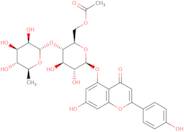
Información del producto
- 4H-1-Benzopyran-4-one, 5-((6-O-acetyl-4-O-(6-deoxy-alpha-L-mannopyranosyl)-beta-D-glucopyranosyl)oxy)-7-hydroxy-2-(4-hydroxyphenyl)-
- 4H-1-Benzopyran-4-one, 5-[[6-O-acetyl-4-O-(6-deoxy-α-<span class="text-smallcaps">L</smallcap>-mannopyranosyl)-β-<smallcap>D</span>-glucopyranosyl]oxy]-7-hydroxy-2-(4-hydroxyphenyl)-
- 5-[[6-O-Acetyl-4-O-(6-deoxy-α-<span class="text-smallcaps">L</smallcap>-mannopyranosyl)-β-<smallcap>D</span>-glucopyranosyl]oxy]-7-hydroxy-2-(4-hydroxyphenyl)-4H-1-benzopyran-4-one
- 7-hydroxy-2-(4-hydroxyphenyl)-4-oxo-4H-chromen-5-yl 6-O-acetyl-4-O-(6-deoxy-alpha-L-mannopyranosyl)-beta-D-glucopyranoside
Camellianin A is an alkaloid extracted from the plant Camellia oleifera. It has been shown that camellianin A inhibits the growth of cancer cells in vitro and in vivo by inducing apoptosis. This effect is mediated by a caspase-3-dependent pathway and may be due to its ability to scavenge anion radicals. Camellianin A decreases the expression of the protein Mcl-1, which is a key regulator of mitochondrial membrane permeability and thus prevents release of cytochrome c from mitochondria and activation of caspases. Another mechanism for this effect may be the inhibition of histone deacetylase activity, leading to chromatin condensation, DNA fragmentation, and cell death.
Camellianin A has also been shown to have anti-inflammatory properties with inhibitory effects on lipopolysaccharide (LPS) induced production of TNF-α and IL-6 in murine mac
Propiedades químicas
Consulta técnica sobre: 3D-FC74465 Camellianin A
Si desea solicitar un presupuesto o realizar un pedido, por favor añada los productos deseados a su carrito y solicite un presupuesto o pedido desde el carrito. Es más rápido, más barato, y podrá beneficiarse de los descuentos y las ventajas disponibles.





